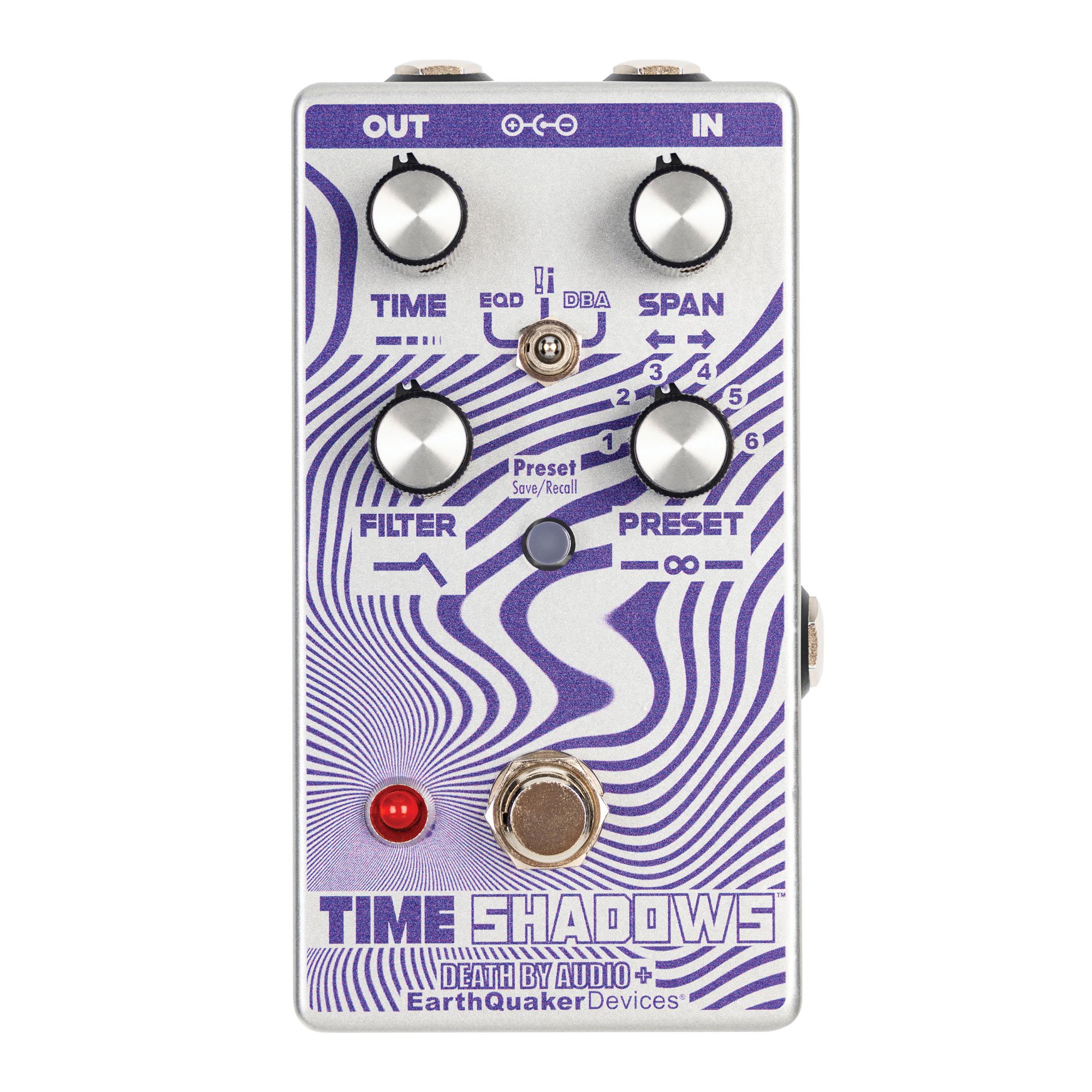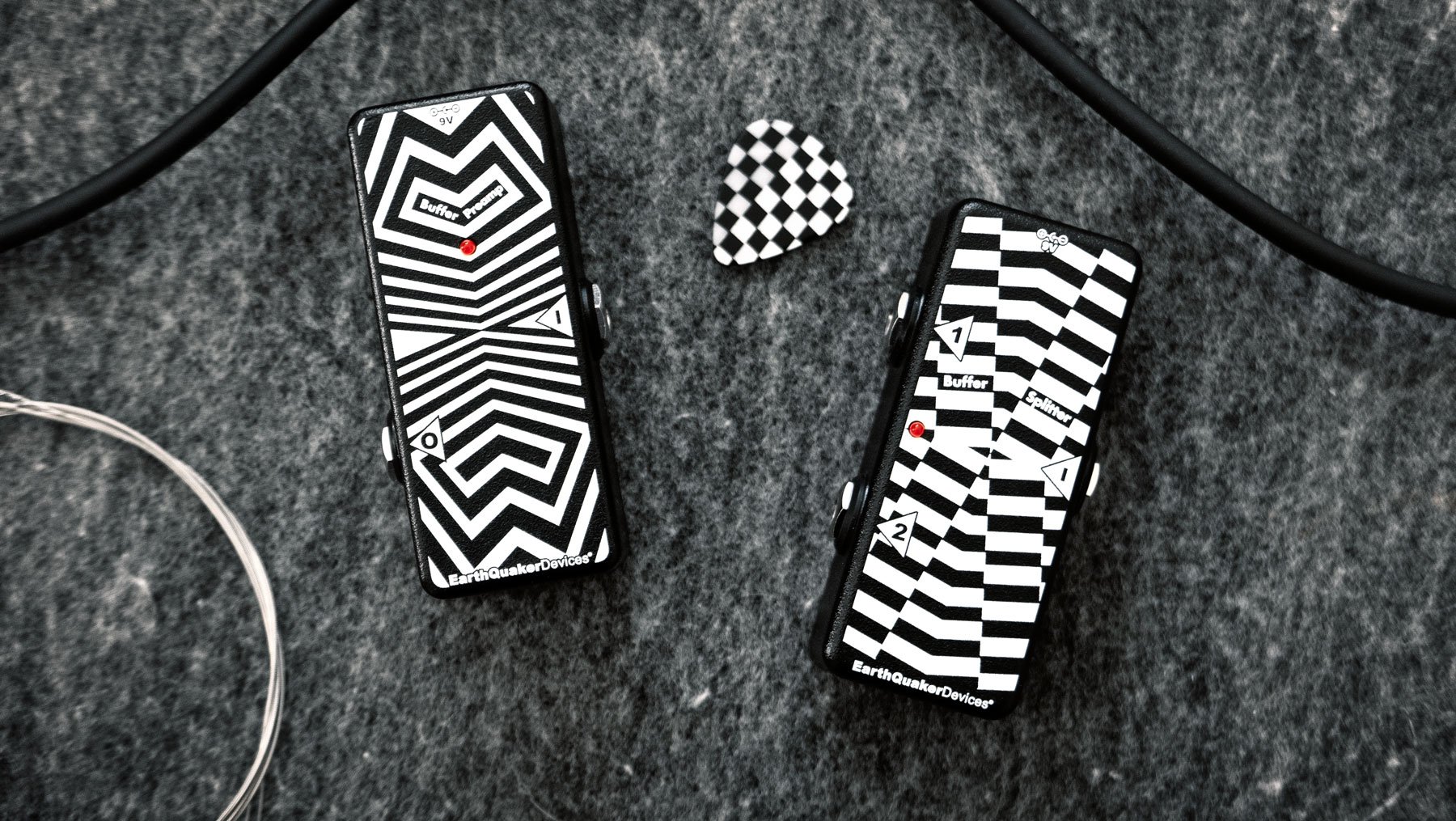Six Ways Time Shadows Totally Melted My Mind
Dan Epstein
I was not always like this, Doctor; I can assure you of that. There was a time when I was a fine, healthy, upstanding member of society, as opposed to the sallow-eyed, gibbering wretch that you see before you. But that was before I encountered EarthQuaker Devices’ Time Shadows, after which my life has never been the same.
The original Time Shadows “Subharmonic Multi-Delay Resonator” — created in an infernal summit between two wizards of the effects realm, EarthQuaker’s Jamie Stillman and Death By Audio’s Oliver Ackermann — had always been little more than a fascinating rumor to me. Released in a limited edition in 2020, the pedal was already sold out and changing hands for big bucks on the collectors’ market by the time its demo videos first began to haunt my dreams. But haunt my dreams, they most certainly did; so when a new, expanded sequel appeared on the horizon, I knew I had to get my hands on one.
And could you blame me, Doctor? For not only does the new Time Shadows feature the same mind-melting circuits that made the original so prized among seekers of sonic arcana — an EQD-designed envelope controlled sub-octave filter delay and a DBA-wrought multi-delay regenerating filter, to be specific — but it also comes with such added attractions as a user-assignable expression jack, six preset slots, and (most enticing of all to me) a mysterious “dual delay” mode that, so it was whispered, “brings your earthly transmissions repetitively closer to the heavens while simultaneously diving deep into the hells.” I was utterly powerless to resist.
On the fateful day that the Time Shadows finally arrived, I greedily plucked it from my doorstep and hurried into my chambers, where I attempted to unlock its secrets away from the prying ears and eyes of the whimpering lackwits whose imaginations were simply too limited to comprehend this pedal’s unearthly powers. And what I found, Doctor, I can barely bring myself to recount here; and yet, I must. Where do I begin?
THE TUBA-CELLO FROM HELL
With the pedal in EQD mode — and placed between my Strat and my Marshall — I turned its control knobs with trembling fingers. Time, I soon learned, alters the signal’s delay time. Span adjusts the intensity of repletion, and Filter (at least in this mode) serves an envelope control for the filter frequency, and a gate for the cutoff to the input of the delay. Before I knew it, I found myself cranking the Time and Filter knobs all the way up to 5 o’clock, while leaving the Span set low at 7 o’clock, and plucking out single notes on my lower E and A strings. And oh, the terrifying sounds that setting created, Doctor! Was it a cello groaning from the depths of Hell itself? Or was it a tuba doing the same? I shudder even as I recall it now, the way that the cranked Filter knob caused the notes to roar viciously to life like demons disturbed from their vile slumbers. “Dare I go on?” I wondered to myself. But I had to, I tell you. I had to!
SPACE PULSE
Determined to boldly go where no mere mortal had gone before, I plugged my expression pedal into the Time Shadows EXP jack. After turning the Span control up to 5 and setting the Filter at around 2, I set the expression pedal in “toe down” position and wiggled the Time knob to assign that control to the EXP jack. Easing back slightly on the expression pedal, I realized that each note I plucked vibrated as if it were suspended in outer space, and that each subsequent plucked note overlapped with it, creating an eerily pulsating chord. The sound of this was gorgeous and enchanting, and I could have luxuriated in it for hours — maybe I even did. But then some madness possessed me to rock the expression pedal all the way backward, and suddenly I was hurtling through hyperspace, with the echoes of my notes falling rapidly away behind me in a neon-colored blur of pitch-hurtling trails…
SPACE SHIMMER
I must have passed out from the shock, Doctor; because when I came to, the Time Shadows was now in DBA mode. I gingerly unplugged my expression pedal, hoping to calm the raging space demons that I had apparently unleashed, at least until I could find a way to regain my bearings. Thankfully, I soon stumbled upon the most delightful of settings: With the Time and Span knobs set at Noon, and the Filter cranked to 5, the pedal produced a shimmering interstellar delay that sounded especially lovely when fingerpicking along the G, B and high E strings. It sounded something like Spacemen 3 meets The Cure, yet oddly cheerier; and for a time, at least, it soothed my tortured soul.
BLACK HOLE
And there, Doctor, I could have happily stayed. And perhaps I should have, but I knew there was so much more of the Time Shadows to explore. Up to 5 o’clock went the Time and Span controls, and back out came my expression pedal, this time with the Filter assigned to the EXP jack. Subtly moving the expression pedal from all the way forward to about midway back while playing the guitar added strange and magical overtones to my delayed notes, but kicking the pedal all the way back made them sound as if they’d been suddenly swallowed up into a cosmic black hole. And then, Doctor, I kicked the pedal forward… and it was as if the black hole had vomited forth the notes back up in partially digested form. What kind of dark sorcery was this?
RAYGUN REVELATION
Nonetheless, I had to see for myself exactly what this “dual delay” mode was all about. I once again disengaged the expression pedal; I then turned the Time knob down to 7 o’clock, and set both the Span and Filter controls at 5. I clicked the Mode switch into its middle position, and played a note… and I swear to you, Doctor, it was as if my guitar had magically transformed into a raygun! And not your dimestore “Pew! Pew!” model, either — but rather one firing a cascade of simultaneously ascending and descending notes that seemed to tear a hole in the fabric of time and space itself. I was dazed at first by this unexpected sonic outburst, but then I blasted it again, and again, and again…
DIMINISHED 7TH NERVOUS BREAKDOWN
Throwing caution to the wind, I turned the Time knob all the way up to 5 o’clock, while leaving the Span and Filter controls at 5 and the Mode switch in its middle position. I plucked a string, and was completely taken aback when the note I’d played produced a diminished 7th arpeggio that kept ascending until it disappeared from earshot. I did it again, and realized that not only was the note going up in this fashion, but it was simultaneously going down! I plucked another note, and then another, hypnotized by the way the ascending and descending notes danced around each other like mischievous pixies; the bizarre harmonies they made together were as addictive as they were entrancing, and I kept concocting new melodic lines to see how they would come together and split apart…
And that’s how they found me, Doctor — passed out on the floor in front of my amp in a state of complete and total exhaustion, with those unearthly diminished 7th arpeggios still ringing in my ears. They took my Time Shadows away from me; they told me that I needed to rest and regain my health before I could go anywhere near it again. But all I can think about is how badly I want to plug into it, and how I must discover for myself what it can do in conjunction with my fuzz, echo and reverb pedals. I have heard them whispering that I have gone mad, and that the Time Shadows has melted my mind. I beg of you to tell me, Doctor: Do you think me mad? Do you?
Dan Epstein is an author, editor, journalist and guitarist based in New York's Hudson Valley. He writes about his latest musical obsessions at Jagged Time Lapse, and songs from his latest musical project The Corinthian Columns can be found at corinthiancolumns.bandcamp.com












